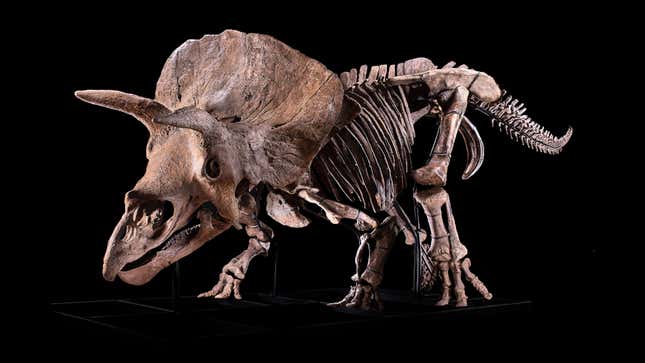
Paleontologists have long speculated that the horns and frill of Triceratops, in addition to providing a formidable defense against predators, were also used to fight members of the same species. Scientists say they’ve found the most compelling evidence yet in favor of this intriguing possibility.
I have great respect for Triceratops and any other prey animal, whether extinct or extant, that must defend itself against predators. Tyrannosaurs are known for preying upon Triceratops, but it gives me great satisfaction to know that these gigantic herbivores, with their long horns and large frills, didn’t go down without a fight. In at least one instance, both the Triceratops and T. rex may have been killed while battling each other.
But in addition to defense against predators, the horns and frill of Triceratops could have served other purposes, such as to attract mates. Another possibility raised by paleontologists is that these physical features were also a defense during combat with “conspecifics,” a fancy term meaning members of the same species.
This idea has been around for a while, and it’s generally agreed that Triceratops did indeed engage in intra-species, or intraspecific, combat, as evidenced by frequent wounds seen on their fossilized frills. New research in Scientific Reports provides further evidence to support this claim, showing that a wound on the famous Big John fossil can be best explained as coming from another Triceratops.
Big John is among the largest Triceratops skeletons ever found. Dated to around 66 million years old, the fossil was discovered at the Upper Cretaceous Hell Creek Formation of South Dakota in 2014. The aptly named specimen stood nearly 8 feet at the hips and measured over 26 feet in length. The Big John fossil sold at auction last year to an unnamed U.S. collector, fetching an unreal price of $7.7 million. The skull and frill, which measures nearly 9 feet long, exhibits an apparent traumatic lesion, which the animal presumably acquired during a fight with another dinosaur.

Injuries such as the one seen on Big John have led paleontologists to speculate about conspecific combat among Triceratops, but as the authors of the new study argue, this evidence has been lacking. Specifically, the scientists, led by Ruggero D’Anastasio from G. D’Annunzio University of Chieti–Pescara in Italy, say what’s really needed is microscopic evidence of bone healing and remodeling (the latter being the final phase of bone healing, as exhibited by ongoing bone growth and improved blood circulation at the injury site).
To that end, D’Anastasio and colleagues analyzed the keyhole-shaped opening on Big John’s right squamosal bone, an opening termed the “fenestra.” That fenestrae are caused by injuries, and not something else, has not been firmly established, leading to two theories.
“The first hypothesis claims that squamosal fenestrae are of traumatic origin, probably as the result of intraspecific fighting or attacks by predators, such as Tyrannosaurus,” write the scientists in the study. “The second hypothesis argues that the squamosal fenestrae are not pathological, but are the result of bone resorption related to aging, or of bone removal for bone that was no longer necessary from a biomechanical and structural point of view.”
But as their investigation revealed, Big John’s hole very much appears to have been the result of an injury. It exhibited irregular features and plaque-like deposits of bone—a possible product of inflammation stemming from an infection. An analysis of the area surrounding the fenestra showed signs of both bone healing and remodeling, as evidenced by small pits known as Howship lacunae. What’s more, the bone around the fenestra was more porous than the surrounding bone, again a sign of healing. These specific features, the scientists argue, could not have appeared after death. Interestingly, the healing process observed in Triceratops bears a striking resemblance to what’s seen in mammals, according to the paper.

“The results of the histological and chemical analyses show that the bone that circumscribed and partially filled the lesion had been made up of metabolically active and remodelling tissue,” the scientists write. “The fenestra is therefore of traumatic origin, and at the time of the death of Big John, the lesion was still healing.”
D’Anastasio’s team goes on to suggest that the injury was not inflicted by a predator but by another Triceratops, and that it happened roughly six months prior to Big John’s death. The size of the hole and the location of the puncture on the frill are consistent with this hypothesis, the scientists say, who boldly declare that the new study “confirms the existence of intraspecific fighting in Triceratops.”
As the paper also points out, the wound appears to have been inflicted from behind. Paleontologists have previously modeled the manner in which Triceratopses would’ve fought amongst themselves, but this attack-from-behind strategy had never been proposed before. These one-on-one battles were likely more dynamic than we assumed.